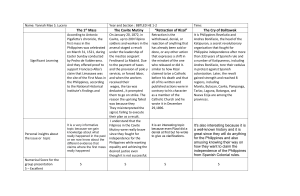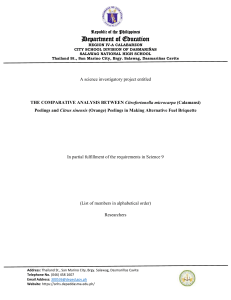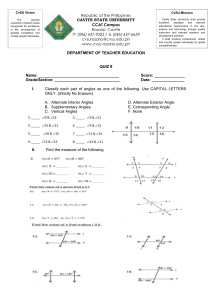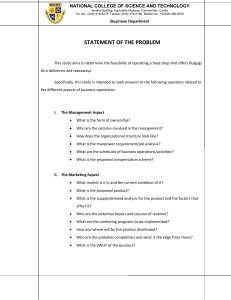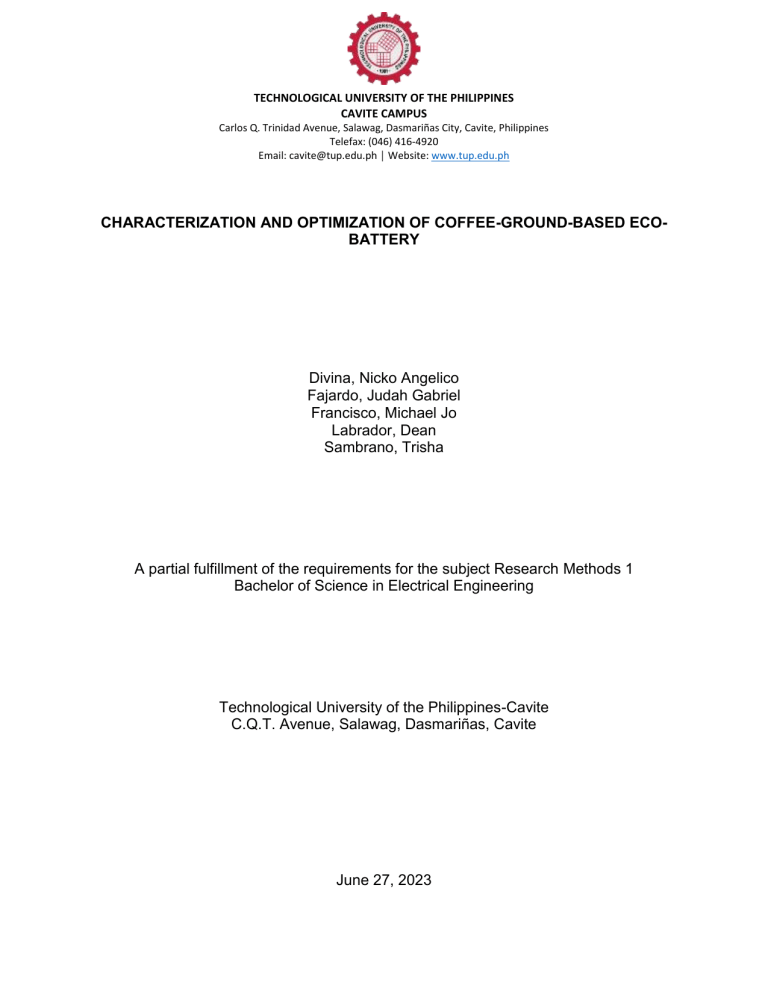
TECHNOLOGICAL UNIVERSITY OF THE PHILIPPINES CAVITE CAMPUS Carlos Q. Trinidad Avenue, Salawag, Dasmariñas City, Cavite, Philippines Telefax: (046) 416-4920 Email: cavite@tup.edu.ph │ Website: www.tup.edu.ph CHARACTERIZATION AND OPTIMIZATION OF COFFEE-GROUND-BASED ECOBATTERY Divina, Nicko Angelico Fajardo, Judah Gabriel Francisco, Michael Jo Labrador, Dean Sambrano, Trisha A partial fulfillment of the requirements for the subject Research Methods 1 Bachelor of Science in Electrical Engineering Technological University of the Philippines-Cavite C.Q.T. Avenue, Salawag, Dasmariñas, Cavite June 27, 2023 TECHNOLOGICAL UNIVERSITY OF THE PHILIPPINES CAVITE CAMPUS Carlos Q. Trinidad Avenue, Salawag, Dasmariñas City, Cavite, Philippines Telefax: (046) 416-4920 Email: cavite@tup.edu.ph │ Website: www.tup.edu.ph Table of Contents CHAPTER 1: THE PROBLEM AND ITS BACKGGROUND .............................................................. 4 Introduction ........................................................................................................................................... 4 Background of the Study ................................................................................................................... 4 Objectives of the Study ...................................................................................................................... 5 General Objectives .......................................................................................................................... 5 Specific Objectives .......................................................................................................................... 5 Theoretical Framework ....................................................................................................................... 6 Statement of the Problem .................................................................................................................. 7 Scope and Delimitations .................................................................................................................... 7 Significance of the Study ................................................................................................................... 8 Definition of Terms .............................................................................................................................. 9 CHAPTER 2: REVIEW OF RELATED LITERATURE ......................................................................... 9 Conceptual Literature ......................................................................................................................... 9 Coffee .................................................................................................................................................. 9 Coffee grounds ............................................................................................................................... 10 Arabica Coffee Beans ................................................................................................................... 10 Robusta Coffee Beans (Coffea caniphora) .............................................................................. 10 Liberica Coffee Beans (Coffea liberica) ................................................................................... 11 Excelsa Coffee Beans (Coffea excelsa) ................................................................................... 12 Battery ................................................................................................................................................ 12 Eco-Battery ...................................................................................................................................... 12 Lithium – Ion Batteries.................................................................................................................. 13 Research Literature ........................................................................................................................... 13 Significance and Optimization Performance of Electrode in Battery .............................. 13 Biodegradable Materials Eco Battery ....................................................................................... 14 Relevance to the Present Study ..................................................................................................... 16 CHAPTER 3: METHODOLOGY ............................................................................................................ 17 Project/Research Design ................................................................................................................. 17 Project Development ......................................................................................................................... 18 TECHNOLOGICAL UNIVERSITY OF THE PHILIPPINES CAVITE CAMPUS Carlos Q. Trinidad Avenue, Salawag, Dasmariñas City, Cavite, Philippines Telefax: (046) 416-4920 Email: cavite@tup.edu.ph │ Website: www.tup.edu.ph Operation/Testing Procedure ......................................................................................................... 20 Evaluation Procedure ....................................................................................................................... 21 Evaluation Criteria ............................................................................................................................. 22 Instruments and Techniques Used ............................................................................................... 22 REFERENCES ......................................................................................................................................... 22 APPENDICES....................................................................................................................................... 26 TECHNOLOGICAL UNIVERSITY OF THE PHILIPPINES CAVITE CAMPUS Carlos Q. Trinidad Avenue, Salawag, Dasmariñas City, Cavite, Philippines Telefax: (046) 416-4920 Email: cavite@tup.edu.ph │ Website: www.tup.edu.ph CHAPTER 1: THE PROBLEM AND ITS BACKGGROUND Introduction Background of the Study Coffee is one of the most popular beverages in the world, and its consumption generates a significant amount of waste in the form of used coffee grounds. According to Statista Research Department (2023), the total coffee consumed in the Philippines in 2020-2021 was about 3.3 million 60-kilogram bags. This reflects a long-term increase in coffee consumption over the years, a significant portion of which ends up in landfills and contributes to environmental degradation. [1] However, recent research has shown that coffee grounds have the potential to be repurposed as a source of renewable energy. In particular, they can be used to produce biofuels, biogas, and other energy sources through various processes, including anaerobic digestion, pyrolysis, and fermentation. [2] TECHNOLOGICAL UNIVERSITY OF THE PHILIPPINES CAVITE CAMPUS Carlos Q. Trinidad Avenue, Salawag, Dasmariñas City, Cavite, Philippines Telefax: (046) 416-4920 Email: cavite@tup.edu.ph │ Website: www.tup.edu.ph Despite the increasing demand for sustainable energy sources, traditional battery technologies remain a significant contributor to environmental pollution due to their use of non-renewable materials and the disposal of toxic waste. Therefore, there is a need to develop sustainable and eco-friendly alternatives to traditional batteries. Recently, it has come to light that ordinary waste materials like coffee grounds might be used to create eco-batteries. [3] This study may aim to characterize the properties of the coffee grounds, such as their composition, and structure, and optimize the conditions for using them in battery technology. It may also evaluate the performance of the coffee ground-based batteries in terms of their energy storage capacity, charge-discharge of the battery, and cycling stability. Objectives of the Study The researcher aims to develop, optimize, and promote sustainable and ecofriendly energy storage technology using coffee grounds as a raw material. General Objectives We researchers aim to develop and test a sustainable and eco-friendly energy storage technology using coffee grounds. Specific Objectives We aim to compare the performance of the eco-battery made from different types of coffee grounds. TECHNOLOGICAL UNIVERSITY OF THE PHILIPPINES CAVITE CAMPUS Carlos Q. Trinidad Avenue, Salawag, Dasmariñas City, Cavite, Philippines Telefax: (046) 416-4920 Email: cavite@tup.edu.ph │ Website: www.tup.edu.ph We aim to compare the performance of the coffee ground-based eco-battery to the traditional battery. To test and evaluate the performance of the coffee ground-based eco-batter prototype by measuring variables such as: Amount of coffee grounds Charge-discharge of the battery Capacity of the battery Lifespan of the battery Theoretical Framework Energy storage devices and equipment are essential in maintaining backup power and supporting grid electrical supply. Several storage devices, specifically some battery classes cause environmental issues such as they are toxic in water that destroys aquatic life. There are also many types of batteries which have high production and material cost. In addressing those problems many battery types are introduced that have minimal pollution effects such as carbon batteries. In accordance with the battery production process, some materials can be used as an alternative to reduce the cost. [4] A study was conducted which says that the carbon in anode side research in battery was quite rare because of difficulties in modifying the anode due to erosion resulting to poor performance and formation of dendrites. [5] Lacking knowledge on that field create a barrier to find alternative materials that can improve or maintain the performance of some carbon battery. As the researchers find that coffee ground has a TECHNOLOGICAL UNIVERSITY OF THE PHILIPPINES CAVITE CAMPUS Carlos Q. Trinidad Avenue, Salawag, Dasmariñas City, Cavite, Philippines Telefax: (046) 416-4920 Email: cavite@tup.edu.ph │ Website: www.tup.edu.ph potential as an alternative material for creating carbon electrodes for anode side of a battery, it may improve existing design of the carbon battery which has issues like performance in high temperature. [6] However, many studies focused on coffee grounds as a whole or only some varieties like Arabica or Liberica only and did not classify different varieties of coffee grounds based on their capacity which may have different performance when in terms of different temperature. [7] [8] [9] [10] Statement of the Problem The researcher aims to address the following problem: Problem 1. What are the characteristics and properties of coffee groundbased eco-battery? Problem 2. How can the performance of an eco-battery made of coffee grounds be improved? Problem 3. When can coffee grounds-based eco-batteries be a sensible alternative to traditional batteries in practice? Problem 4. How does the eco-battery compare to traditional batteries in terms of effectiveness, capacity, and lifespan? Problem 5. How are the various coffee beans affect the characteristics and performance of coffee ground-based eco-batteries? Scope and Delimitations The scope of this study is to characterize and optimize a coffee-based eco-battery as an alternative energy storage device. The study will focus on evaluating the TECHNOLOGICAL UNIVERSITY OF THE PHILIPPINES CAVITE CAMPUS Carlos Q. Trinidad Avenue, Salawag, Dasmariñas City, Cavite, Philippines Telefax: (046) 416-4920 Email: cavite@tup.edu.ph │ Website: www.tup.edu.ph performance and properties of the eco-battery, including its power output, energy density, stability, and environmental impact. The study will be limited to characterization and optimization of a coffee based eco-battery. Significance of the Study This research study is conducted in order to contribute a knowledge about the Characterization and Optimization of Coffee Ground-Based Eco-Battery. The researchers aim to develop and test a sustainable and eco-friendly energy storage technology using coffee grounds. Through this research some policies and practices may be improved by some professionals like allowing the students to compare the performance of the coffee groundbased eco-battery to the traditional battery. The following will be the one who will benefit this research: Students. Students, especially in Technological University of the Philippines can benefit on this research study, somehow, it will be a big help to them because they will become more familiar to the problems they might encounter. Teachers/Professors/Instructors. Instructors who will use this research in teaching will also benefit to this research. They can also set new practices and methods when using the said topic. TECHNOLOGICAL UNIVERSITY OF THE PHILIPPINES CAVITE CAMPUS Carlos Q. Trinidad Avenue, Salawag, Dasmariñas City, Cavite, Philippines Telefax: (046) 416-4920 Email: cavite@tup.edu.ph │ Website: www.tup.edu.ph Future Researchers. This conducted research study can be served as a reference to those future researchers that also want to have a further study related to this research. They may use it for another developmental study they may have. Definition of Terms CHAPTER 2: REVIEW OF RELATED LITERATURE Conceptual Literature Coffee Everyone recognizes a roasted coffee bean, but you might not recognize an actual coffee plant. Coffee trees are pruned short to conserve their energy and aid in harvesting, but can grow to more than 30 feet (9 meters) high. Each tree is covered with green, waxy leaves growing opposite each other in pairs. Coffee cherries grow along the branches. Because it grows in a continuous cycle, it’s not unusual to see flowers, green fruit and ripe fruit simultaneously on a single tree. [11] It takes nearly a year for a cherry to mature after first flowering, and about 5 years of growth to reach full fruit production. While coffee plants can live up to 100 years, they are generally the most productive between the ages of 7 and 20. Proper care can maintain and even increase their output over the years, depending on the variety. The average coffee tree produces 10 pounds of coffee cherry per year, or 2 pounds of green beans. [11] TECHNOLOGICAL UNIVERSITY OF THE PHILIPPINES CAVITE CAMPUS Carlos Q. Trinidad Avenue, Salawag, Dasmariñas City, Cavite, Philippines Telefax: (046) 416-4920 Email: cavite@tup.edu.ph │ Website: www.tup.edu.ph Coffee grounds Coffee grounds are the leftover results after the brewing process. Used coffee grounds are the leftover results after the brewing process. Sometimes, spent coffee grounds stick to the inside of your coffee maker. Used coffee grounds clump at the bottom of your cup in other situations. [12] Arabica Coffee Beans With roughly 60% of all coffee consumed worldwide coming from Arabica beans, they are by far the most common form of coffee bean. These delicious beans may have been the first coffee beans ever drunk, as they were believed to have originated in the highlands of Ethiopia many millennia ago. The popularity of the beans in 7th-century Arabia (modern-day Yemen) is perhaps where the term Arabica derives from. Arabica beans have the drawback of being more challenging to grow. Arabica beans cost more as a result. In the 50 nations that make up the so-called Bean Belt, which lies between the Tropics of Cancer and Capricorn, all coffee beans are grown. But for Arabica beans to grow properly, additional shade, water, and high altitude are necessary. These plants, which are more vulnerable to ailments and pests, must be grown at an altitude of at least 2,000 feet. They’re also smaller plants, measuring between 8 and 15 feet when fully grown. [13] Robusta Coffee Beans (Coffea caniphora) Robusta is the second-most popular variety of coffee bean. Originally from subSaharan Africa, this bean is now mostly farmed in Africa and Indonesia. It is particularly TECHNOLOGICAL UNIVERSITY OF THE PHILIPPINES CAVITE CAMPUS Carlos Q. Trinidad Avenue, Salawag, Dasmariñas City, Cavite, Philippines Telefax: (046) 416-4920 Email: cavite@tup.edu.ph │ Website: www.tup.edu.ph well-liked in Vietnam and frequently included in coffee mixes. Since it is less expensive, roasters can choose this type without breaking the bank. Compared to other bean kinds, robusta beans are bigger and rounder. Between 15 and 20 feet tall, these plants often grow significantly larger than Arabica plants. Because they can grow at lower elevations and are disease-resistant, robusta beans are often thought of as being more resilient. However, a more recent study contends that they are less heat-tolerant than originally believed. [13] Liberica Coffee Beans (Coffea liberica) Native to central and western Africa—notably Liberia, hence its name—Coffea liberica is regarded for its pungent flowery scent and robust, smokey flavor character. This resilient variety is regularly combined with other types to add body and complexity, but rarely receives any credit. Unheard of in Western civilization before the late 1800s, Liberica developed a stronghold with Southeast Asian coffee producers after a fungal disease (“coffee rust”) wiped out much of the region’s Arabica harvests. [13] The majority of Liberica cherries typically have an irregular form and resemble Robusta more in size and overall look because they come from a much larger plant than Arabica or Robusta. It tolerates hot, muggy weather and grows well at low elevations. The bean now accounts for around 2% of the world's coffee production and is primarily grown in Indonesia, Malaysia, and the Philippines. Liberica beans make up more than 95% of the coffee production in Malaysia. However, it is uncommon in markets in North America and Europe. [13] TECHNOLOGICAL UNIVERSITY OF THE PHILIPPINES CAVITE CAMPUS Carlos Q. Trinidad Avenue, Salawag, Dasmariñas City, Cavite, Philippines Telefax: (046) 416-4920 Email: cavite@tup.edu.ph │ Website: www.tup.edu.ph Excelsa Coffee Beans (Coffea excelsa) Excelsa is the name of the fourth main variety of coffee bean. Scientists recently categorized it as a Liberica variation, despite the fact that it was previously believed to be a distinct coffee species. Excelsa beans are elongated ovals that resemble Liberica beans and are nearly exclusively grown in Southeast Asia. At moderate altitudes, these beans are grown on substantial 20–30-foot coffee plants. [13] [14] Battery A battery is a device that converts chemical energy contained within its active materials directly into electric energy by means of an electrochemical oxidation-reduction (redox) reaction. This type of reaction involves the transfer of electrons from one material to another via an electric circuit. [14] While the term battery is often used the cell is the actual electrochemical unit used to generate or store electric energy. [14] In understanding the differences between a cell and a battery, one should think of a battery as one or more of these cells connected in series, or parallel, or both, depending on the desired output voltage and capacity. [14] Eco-Battery Eco Battery, LLC was formed with a desire to build the best lithium batteries on the planet. Through tireless hours of R&D, we have designed all of our batteries to provide years of trouble free service. We only use the highest quality LiFePo4 cells from the best manufacturers in the world. [14] [15] TECHNOLOGICAL UNIVERSITY OF THE PHILIPPINES CAVITE CAMPUS Carlos Q. Trinidad Avenue, Salawag, Dasmariñas City, Cavite, Philippines Telefax: (046) 416-4920 Email: cavite@tup.edu.ph │ Website: www.tup.edu.ph Lithium – Ion Batteries The emergence of lithium-ion batteries in the last couple of decades has been quite phenomenal. More than 50% of the consumer market has adopted the use of lithium-ion batteries. Particularly, laptops, mobile phones, cameras, etc. are the largest applications of lithium-ion batteries. Lithium-ion batteries have significantly high energy density, high specific energy and longer cycle life. Other main advantages of lithium-ion batteries are slow self-discharge rate and wide range of operating temperatures. [15] Research Literature Significance and Optimization Performance of Electrode in Battery In producing carbon batteries, it is composed of three major sides which are the electrolytes, cathode, and anode side. The electrode is one of the essential parts of the anode side who transfers ions from high concentration to the low side. [16] It also transfers electrical energy to polarized devices. Yang et. al (2018) study that due to the significance of the electrodes in the battery, optimization and improvement is quite important. They summarized the problem in constructing electrodes which affect the performance of lithium-ion batteries (a type of battery that uses carbon electrodes) in terms of energy waste. [17] [18] [19] In optimizing the anode side of the battery, carbon electrodes have problems in terms of performance of the lithium-ion battery. According to Zheng et. al (2023), the thickness is one of the factors that underperformed in the electrochemical aspect and has TECHNOLOGICAL UNIVERSITY OF THE PHILIPPINES CAVITE CAMPUS Carlos Q. Trinidad Avenue, Salawag, Dasmariñas City, Cavite, Philippines Telefax: (046) 416-4920 Email: cavite@tup.edu.ph │ Website: www.tup.edu.ph weak mechanical stability. In those factors, optimization and modifying the materials for electrodes production is effective to reduce the poor performance of anode side. [20] In recent studies of Collins G., et. al (2018), they prove that using alternative materials for creating carbon electrodes have outstanding results in terms of energy flow. [21] Specifically biodegradable materials have high performance like nanocomposite anode made out of corn which showed high performance level in cyclic cycle, higher specific capacity and the electrochemical performance was improved. It is established evidence that carbonization of biodegradable materials can apply in substituting common ingredients for creating carbon electrodes. Biodegradable Materials Eco Battery The increasing attention towards environmentally friendly battery replacements has led to the exploration of biodegradable materials such as coffee, banana, corn, citrus, and others. Traditional batteries, made from non-renewable resources and causing pollution during manufacture and disposal, could be replaced by these substances. In a recent study by W. Ma et al. (2023), banana peels are a creative and abundant biowaste item that can be utilized for batteries. Activated banana peels (ABP) can be prepared by adding electroactive nanomaterials to them, taking advantage of their naturally occurring porous structure. ABP electrodes have shown promise in asymmetric supercapacitors and lithium-ion batteries. [22] Coffee grounds for instance, are also being studied for their potential in biodegradable batteries. According to H. Parsimehr and A. Ehsani (2020), the high TECHNOLOGICAL UNIVERSITY OF THE PHILIPPINES CAVITE CAMPUS Carlos Q. Trinidad Avenue, Salawag, Dasmariñas City, Cavite, Philippines Telefax: (046) 416-4920 Email: cavite@tup.edu.ph │ Website: www.tup.edu.ph cellulose content in coffee grounds can be converted into activated carbon, serving as the battery's anode. The porous structure of coffee grounds provides a large surface area for electrochemical reactions, making them suitable for energy storage. [23] In the research of Zhang Y., et. Al (2016), they analyze that among corn-based materials, corn stalk biochar has demonstrated excellent electrochemical properties for electrode batteries, including initial discharge capacity and cycle stability. Additionally, corn cob offers a low-cost option to produce biochar for battery electrodes. [24] Citrus fruit peels, known for their natural antioxidants and polyphenols, are also being investigated by Ehsani, et. Al (2020). They point out that electrodes made from citrus fruit peel and residue exhibit promising electrochemical performance, making them suitable for electrochemical energy storage devices. [23] The studies proven that batteries made out of biodegradable materials like coffee grounds, banana, corn, citrus, and others holds great promise for sustainable energy storage. It has high performance to be an alternative to traditional battery. By utilizing renewable resources and minimizing environmental impact, these eco-batteries can contribute to a greener and more sustainable future. The lithium-ion battery is one of many types of battery that are using electrodes in anode side. Since it is usually mad out of graphite material, biodegradable material can use as the alternative for that. According to the study of Mishra A., et. Al, (2018), lithiumion battery electrode materials are primarily concerned with improving their capabilities and removing limitations for high-power applications. Common electrode materials for TECHNOLOGICAL UNIVERSITY OF THE PHILIPPINES CAVITE CAMPUS Carlos Q. Trinidad Avenue, Salawag, Dasmariñas City, Cavite, Philippines Telefax: (046) 416-4920 Email: cavite@tup.edu.ph │ Website: www.tup.edu.ph anodes and cathodes have been modified by element doping and coatings. These changes led to an improvement in the mobility and conductivity of the ions and an increase in the specific capacity of the lithium ions. The performance of traditional electrode materials has been improved through element doping, coating, and combination with other materials. These changes increased Li-ion diffusivity, conductivity, ion mobility, and capacity during the charge and discharge processes. Improving the efficiency of lithium-ion batteries in large quantities has significant potential. To evaluate the performance of these materials, a number of metrics including cycling stability, specific capacity, specific energy, and charge/discharge rate were thoroughly investigated. [25] In the study, the current status of electrode materials for lithium-ion batteries is extremely encouraging, offering prospects for improving battery performance and reducing reliance on fossil fuels for power generation. Relevance to the Present Study In past studies, different types of batteries have many issues in terms of electrochemical performance. The performance is limited by different factors such as thickness of electrodes, high operation rate, sizing of particle materials. According to Kim JH (2022), with those factors, the anode side of the battery has much higher challenges in optimization because materials in creating electrodes underperform in thermal stability and it cannot avoid the expansion of its volume size. In that case characterization and optimization of material for creating an electrode is significant to study which closely performs or has higher performance rate than existing electrode types in batteries. [26] TECHNOLOGICAL UNIVERSITY OF THE PHILIPPINES CAVITE CAMPUS Carlos Q. Trinidad Avenue, Salawag, Dasmariñas City, Cavite, Philippines Telefax: (046) 416-4920 Email: cavite@tup.edu.ph │ Website: www.tup.edu.ph Pellegrini V., et. al (2019) also analyzes that graphite in lithium-ion batteries has limited specific capacity which hinders the electrons to flow freely from the anode side to create a positive current collector. They observed that it only delivers a capacity of 350 mAh/g practically and theoretically it generates only around 372 mAh/g. With that said silicon can be used as an alternative for graphite that has higher capacity and performance however it has much higher cost so that studying other materials that will undergo characterization and optimization as substitutes for electrodes is essential. [27] CHAPTER 3: METHODOLOGY Project/Research Design The researcher will introduce a rough sketch or outline of the project that shows the expected outcomes of the study. TECHNOLOGICAL UNIVERSITY OF THE PHILIPPINES CAVITE CAMPUS Carlos Q. Trinidad Avenue, Salawag, Dasmariñas City, Cavite, Philippines Telefax: (046) 416-4920 Email: cavite@tup.edu.ph │ Website: www.tup.edu.ph Figure 1. An outline of the process in creating coffee ground base eco-battery Project Development This section is about the development and optimization of a coffee grounds-based eco-battery as a sustainable and eco-friendly energy storage technology. The sample coffee grounds materials that were used in this study are naturally acquired from the coffee shop in GMA, Cavite. All the materials used were also categorized based on their variety such as arabica, robusta, liberica and excelsa which is essential to determine if those have a significant effect on the performance of the coffee ground based eco battery. The process begins with the production of biochar from coffee grounds and focuses on carbonization and activation to obtain high-quality conductive carbon electrodes. The eco-battery is then assembled from these electrodes together with TECHNOLOGICAL UNIVERSITY OF THE PHILIPPINES CAVITE CAMPUS Carlos Q. Trinidad Avenue, Salawag, Dasmariñas City, Cavite, Philippines Telefax: (046) 416-4920 Email: cavite@tup.edu.ph │ Website: www.tup.edu.ph separators, electrolytes, and current collectors. The performance of the eco battery is evaluated through various tests and parameters, including the quantity of coffee grounds spent and charge-discharge cycles. Data analysis techniques such as voltage testing, ohmic testing, full cycle test, and SOLI test are used to compare the effectiveness, capacity, and lifespan of eco-batteries versus traditional batteries. This section also aims to establish a robust methodology for the creation and evaluation of eco-batteries based on coffee grounds, paving the way for sustainable and eco-friendly energy storage solutions. To create the coffee ground base eco-battery this process must be done: In creating biochar products, the thermochemical conversion process is essential in treating the coffee grounds. In the first procedure, the weighted spent coffee grounds will undergo a drying process in 60 °C temperature to ensure that there is no other extraneous matter that combines and maintains the moisture content of the product. [28] The dried coffee rounds will introduce a torrefaction process which preheats the material in 200-320 °C temperature to break down chemical bonds within the material that create a crip, char-type material. Within a temperature of 250-300 °C, it undergoes an exothermic pyrolysis process which removes the oxygen compound, and in 400 °C it will turn into zero oxygen charcoal like remains. When the temperature reaches the 500-600 °C mark, the process turns it into typical fixed carbon content which totally breaks down the compound content that combines to it. It will continue the process until it reaches a temperature above 700 °C which activates the carbon material. [29] TECHNOLOGICAL UNIVERSITY OF THE PHILIPPINES CAVITE CAMPUS Carlos Q. Trinidad Avenue, Salawag, Dasmariñas City, Cavite, Philippines Telefax: (046) 416-4920 Email: cavite@tup.edu.ph │ Website: www.tup.edu.ph In the construction of electrodes for the battery application, the 0.7g of carbon powder is blended with 0.35 ml of nafion solution (15-20 mL of H₂O and 80-85 mL of C₂H₆O) for a few minutes. After creating the mixture, it undergoes a molding process into the desired CPE holder size, and it will be heated to 300 °C temperature to make the exact outcome of the carbon electrode rod. [30] In the process of creating the carbon battery, the carbon electrodes and the manganese dioxide will be mixed with the carbon powder (the ratio should be 1:1). In the silicone tube, insert the carbon electrode rod with the MNO₂ and carbon powder mixture. In an ammonium chloride solution, soak the cotton in it and insert it into the tube. Attached a metallic cover to the cap to make the mixture inserted on the battery secure. Operation/Testing Procedure This section introduces the step-by-step procedures in analyzing the performance of coffee ground based eco batteries used to ensure that the specified requirement is met versus the traditional carbon-based battery. It will undergo 4 different tests including voltage test, ohmic test, full cycle test, and state of life indicator test. With the use of the multimeter, the voltage and internal resistance of the ecobattery will be measured. In voltage tests, when there is no load that the battery supplies, battery voltage considering the state of charge in an open circuit. It is also important to have an ohmic test measuring the internal resistance of the battery because it identifies when mechanical defects occur. The battery also undergoes a full cycle test which involves the charging and discharging capacity. In the discharging cycle, the battery will TECHNOLOGICAL UNIVERSITY OF THE PHILIPPINES CAVITE CAMPUS Carlos Q. Trinidad Avenue, Salawag, Dasmariñas City, Cavite, Philippines Telefax: (046) 416-4920 Email: cavite@tup.edu.ph │ Website: www.tup.edu.ph be connected to an electronic alternative load circuit and will measure the power capacity with constant current to ensure that there are no changes in capacitance and time that affects the results of real time capacity test. The formula with constant current when testing the capacity is Cd=I·td, where Cd is capacity of the battery, I is the current in milliampere, and t is the discharge duration. In the state of life indicator test, the researchers calculate the battery life depending upon delivered energy. [31] The formula of the state of charge of the battery is capacity remaining over total capacity (SOC=Cr/Ct) which is the unit of amp power. [32] Figure. 2. An example of voltage over discharge capacity graph. [33] Evaluation Procedure The researchers will gather the data in different tests such as the voltage test, ohmic test, full cycle, and SOLI. The researchers will evaluate the data with respect to different varieties of coffee grounds such as Robusta, Arabica, Excelsa, and Liberica in which the data will compare to the traditional carbon battery if there a significant result in TECHNOLOGICAL UNIVERSITY OF THE PHILIPPINES CAVITE CAMPUS Carlos Q. Trinidad Avenue, Salawag, Dasmariñas City, Cavite, Philippines Telefax: (046) 416-4920 Email: cavite@tup.edu.ph │ Website: www.tup.edu.ph which shows that which type of coffee grounds has results that have ideal performance than other coffee grounds base eco battery and traditional carbon battery. Evaluation Criteria Instruments and Techniques Used These are the instruments or tools for gathering data in research used as a basis for analyzing conclusions or making interpretations. Some of these tools together with observation of the experiment and testing are applied for calculating parameters such as voltage, current, resistance, charging and discharging, and capacity of the coffee ground base eco battery. Multimeter The measuring tool is used to calculate the voltage, current and resistance generated by the battery. Electronic Alternative Load Circuit It is an electronic device which is intended to be used as discharging equipment for the power discharging rate test of the battery. REFERENCES [1] N. Kondamudi, S. K. Mohapatra and M. Misra, "Spent Coffee Grounds as a Versatile Source of Green Energy," Journal of Agricultural and Food Chemistry, vol. 56, no. 24, p. 11757–11760, 2008. TECHNOLOGICAL UNIVERSITY OF THE PHILIPPINES CAVITE CAMPUS Carlos Q. Trinidad Avenue, Salawag, Dasmariñas City, Cavite, Philippines Telefax: (046) 416-4920 Email: cavite@tup.edu.ph │ Website: www.tup.edu.ph [2] M. Todaka, W. Kowhakul, H. Masamoto and M. Shigematsu, "Improvement of oxidation stability of biodiesel by an antioxidant component contained in spent coffee grounds," Biofuels, vol. 12, no. 2, pp. 227-235, 2021. [3] Statista, "Philippines: coffee consumption 2021 | Statista," 2023. [4] "Cenex-Events incorporates," Cenex, 7 September 2023. [Online]. Available: https://www.cenex-lcv.co.uk/news-media/exhibitor/what-is-the-environmentalimpact-of-lithiumbatteries#:~:text=Lithium%20batteries%20have%20chemicals%20within,water %20and%20destroying%20aquatic%20life.. [Accessed 28 06 2023]. [5] J. Liang, Z. Sun, F. Li and H.-M. Cheng, "Carbon materials for Li–S batteries: Functional evolution and performance improvement," Energy Storage Materials, vol. 2, p. 76–106, 2016. [6] M. Pagett, K. S. Teng, G. Sullivan and W. Zhang, "Reusing Waste Coffee Grounds as Electrode Materials: Recent Advances and Future Opportunities," Global Challenges, vol. 207, p. 411–417, 2019. [7] F. Luna-Lama and e. al, "Non-porous carbonaceous materials derived from coffee waste grounds as highly sustainable anodes for lithium-ion batteries," Journal of Cleaner Production, vol. 207, p. 411–417, 2019. [8] C. Peng-Hsuan, S.-F. Liu, H. Yu-Hsuan, H. Tseng, C.-H. Guo and H.-Y. Chen, "Coffee-Ground-Derived Nanoporous Carbon Anodes for Sodium-Ion Batteries with High Rate Performance and Cyclic Stability," Energy & Fuels, vol. 34, p. 7666–7675, 2020. [9] I. Pawarangan, M. Pineng and S. A. Anum, "The electrical productivity of Arabica coffee grounds battery based on electrode distance and dryness level," Jurnal Riset Dan Kajian Pendidikan Fisika, vol. 9, p. 1–8, 2022. [10] "M. Brashem, Inc," 19 January 2021. [Online]. Available: https://www.mbrashem.com/why-are-carbon-electrodes-used-in-electrolysis/. [Accessed 28 June 2023]. [11] "4 Types of Coffee Beans: Profiles, Pictures & More," [Online]. Available: https://coffeeaffection.com/different-types-coffee-beans/. [Accessed 27 June 2023]. TECHNOLOGICAL UNIVERSITY OF THE PHILIPPINES CAVITE CAMPUS Carlos Q. Trinidad Avenue, Salawag, Dasmariñas City, Cavite, Philippines Telefax: (046) 416-4920 Email: cavite@tup.edu.ph │ Website: www.tup.edu.ph [12] "What Are Coffee Grounds And What Can You Do With Them?," 27 June 2023. [Online]. Available: https://fullcoffeeroast.com/what-are-coffee-grounds/. [Accessed 27 June 2023]. [13] "What are the Different Types of Batteries?," [Online]. Available: https://www.electronicshub.org/types-of-batteries/. [Accessed 27 June 2023]. [14] "What is a Battery?," [Online]. Available: https://depts.washington.edu/matseed/batteries/MSE/battery.html. [Accessed 27 June 2023]. [15] "What is Coffee?," 27 June 2023. [Online]. Available: https://www.ncausa.org/About-Coffee/What-is-Coffee. [Accessed 27 June 2023]. [16] Richard, "UPS Battery Center," 19 September 2016. [Online]. Available: https://www.upsbatterycenter.com/blog/electrodes-what-theydo/#:~:text=The%20Role%20of%20Electrodes%20in%20the%20Transfer%20 of%20Energy&text=In%20the%20case%20of%20lead,and%20passes%20thro ugh%20the%20device.. [Accessed 27 June 2023]. [17] X. Jiang, Y. Chen, X. Meng, W. Cao , C. Liu, . Q. Huang, N. Naik, V. Murugadoss, M. Huang and . Z. Guo , "Science Direct," May 2022. [Online]. Available: https://www.sciencedirect.com/science/article/abs/pii/S0008622322000884. [Accessed 27 June 2023]. [18] J. J. H. Togonon, P.-C. Chiang, H.-J. Lin, W.-C. Tsai and H.-J. Yen, "Pure carbon-based electrodes for metal-ion batteries," Carbon Trends, vol. 3, p. 100035, 2021. [19] S. Yang, P. He and H. Zhou, "Research progresses on materials and electrode design towards key challenges of Li-air batteries," Energy Storage Materials, vol. 13, pp. 29-48, 2018. [20] J. Zheng, G. Xing, L. J. 1, Y. Lu, N. Qin, S. Gao and J. P. Zheng, "Strategies and Challenge of Thick Electrodes for Energy Storage: A Review," Batteries, vol. 9, p. 151, 2023. TECHNOLOGICAL UNIVERSITY OF THE PHILIPPINES CAVITE CAMPUS Carlos Q. Trinidad Avenue, Salawag, Dasmariñas City, Cavite, Philippines Telefax: (046) 416-4920 Email: cavite@tup.edu.ph │ Website: www.tup.edu.ph [21] G. A. Collins, H. Geaney and K. M. Ryan, "Alternative anodes for low temperature lithium-ion batteries," Journal of Materials Chemistry A, vol. 9, p. 14172–14213, 2021. [22] e. .. Ma Y., "Pyrolyzing spent coffee ground to biochar treated with H3PO4 for the efficient removal of 2,4-dichlorophenoxyacetic acid herbicide: adsorptive behaviors and mechanism," Journal of Environmental Chemical Engineering, vol. 11, no. 1, p. 109165, 2023. [23] H. P. a. A. Ehsani, "Corn‐based Electrochemical Energy Storage Devices," Chemical Record, vol. 20, no. 10, p. 1163–1180, 2020. [24] Z. G. N.-N. S. a. X. L. Y. Zhang, "High-performance supercapacitors and batteries derived from activated banana-peel with porous structures," Electrochimica Acta, vol. 222, p. 1257–1266, 2016. [25] A. M. e. al., "Electrode materials for lithium-ion batteries," Materials Science for Energy Technologies, vol. 1, p. 182–187, 2018. [26] F. J. a. P. Peng, "Elucidating the Performance Limitations of Lithium-ion Batteries due to Species and Charge Transport through Five Characteristic Parameters," Scientific Reports, vol. 6, no. 1, 2016. [27] S. B. D. B. a. K. E. V. Pellegrini, "Challenges and perspectives for new material solutions in batteries," Solid State Communications, vol. 303–304, p. 113733, 2019. [28] C. M. S. L. C. J. B. T. R. S. M. G. Z. L. R. M. K. Shantanu Kelkar, "Fuel Processing Technology," 04 May 2015. [Online]. Available: https://www.sciencedirect.com/science/article/abs/pii/S0378382015001502. [Accessed 24 June 2023]. [29] "Black Wood Technology," 2013. [Online]. Available: https://www.blackwoodtechnology.com/technology/what-is-torrefaction/. [Accessed 24 June 2023]. [30] "MEL Science," October 2019. [Online]. Available: https://melscience.com/USen/chemistry/experiments/battery-v3_zinccarbon/#:~:text=Mix%20some%20manganese%20dioxide%20MnO,will%20be %20the%20battery%20body.. [Accessed 24 June 2023]. TECHNOLOGICAL UNIVERSITY OF THE PHILIPPINES CAVITE CAMPUS Carlos Q. Trinidad Avenue, Salawag, Dasmariñas City, Cavite, Philippines Telefax: (046) 416-4920 Email: cavite@tup.edu.ph │ Website: www.tup.edu.ph [31] "Battery University," 4 March 2020. [Online]. Available: https://batteryuniversity.com/article/battery-test-methods. [Accessed 24 June 2023]. [32] H. Abdi, B. Mohammadi-Ivatloo, S. Javadi, A. Khodaei and E. Dehnavi, "Energy Storage Systems," Elsevier eBooks, p. 333–368, 2017. [33] L. Fried, "adafruit," 16 Febuary 2013. [Online]. Available: https://learn.adafruit.com/all-about-batteries/power-capacity-and-powercapability. [Accessed 24 June 2023]. APPENDICES

